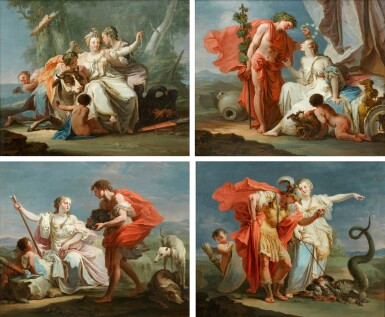The Giordano Collection: Une Vision Muséale Part I
The Giordano Collection: Une Vision Muséale Part I

Attributed to Giovanni Battista Crosato
The Rape of Europa; Atalanta and Meleager; Bacchus and Ariadne; Medea and Jason
Estimate
120,000 - 180,000 EUR
Lot Details
Description
Attributed to Giovanni Battista Crosato
Venice 1686 - 1758
The Rape of Europa
Atalanta and Meleager
Bacchus and Ariadne
Medea and Jason
Oil on canvas, a set of four
(I) 81,3 x 99,2 cm; 32 by 39 in.; (II) 81,5 x 98,4 cm; 32⅛ by 38¾ in.; (III) 81,5 x 98,8 cm; 32⅛ by 38⅞ in.; (IV) 81,2 x 99,5 cm; 32 by 39⅛ in.
(4)
Ernest Ponti (1875-1937), Turin;
His deceased sale, Galerie Moos, Geneva, 2 April 1938, lots 2-5 (as Claudio Francesco Beaumont, unsold or purchased back by the vendor's family);
By descent to Ernest Ponti's great-grandson, Swiss;
Anonymous sale, Christie's, London, 7 July 2009, lot 62 (as Giovanni Battista Crosato);
With Agnew's, London;
Where acquired by the present owner, 2015.
D. Ton, Giambattista Crosato. Pittore del rococò europeo, Fondazione Giorgio Cini, 2012, pp. 395-396, no. R18, fig. 433-436.
Originally from Treviso, Giovanni Battista Crosato trained in Venice and belongs firmly to the generation of painters in the Serenissima who were energized by a fervent desire for renewal – the generation of Amigoni, Ricci, Pellegrini and of course their greatest disciple, Tiepolo.
Though he was an active member of the community of painters in Venice, where in the early 1750s he produced his magnum opus, the ballroom ceiling in the Ca’Rezzonico, he was equally active in Piedmont. In 1733, he moved to Turin, from where he worked on several building projects in the region, before returning to the area of his birth and working in both the Veneto and Piedmont.
His style was at first marked by the tenebrism of the previous century but evolved, under the influence of his compatriots, towards a brighter, lighter palette, with sometimes acid tones, giving some of his works a fantastical appearance that is particularly modern.
Three of these four paintings may be compared with compositions painted by Crosato for the panelling of the Palazzo Carignano: The Rape of Europa, Atalanta and Meleager and Medea and Jason (now in the Museo Civico di Palazzo Madama in Turin, along with four further panels from the series), while the fourth, Bacchus and Ariane, is comparable to a separate composition on panel, also in the Palazzo Carignano.
Additionally, The Rape of Europa in the present series is also linked to a work featuring the same subject in the Wadsworth Atheneum, Hartford (see R. Palluchini, La Pittura nel Veneto - Il Settecento, vol. I, Milan, 1995, p. 137, fig. 199).
Formerly attributed to Claudio Francesco Beaumont, this series of paintings has recently been recognized as the work of Giovanni Battista Crosato, an attribution confirmed by Professors Ugo Ruggeri and Sergio Marinelli on the basis of photographs, at the time of an earlier sale of the paintings in 2009.
Denis Ton, in his monograph on Crosato, has questioned this opinion; he believes that the paintings are certainly the work of a Piedmontese artist of the eighteenth century, close to Vittorio Amedeo Rapous, but inspired by the works Crosato painted for the Palazzo Carignano.
For his part, Professor Ruggeri regards these paintings as works of Crosato’s maturity, stylistically comparable to the frescoes depicting scenes from the life of Alexander the Great, made for the Villa Marcello in Levada in the late 1740s.
You May Also Like










